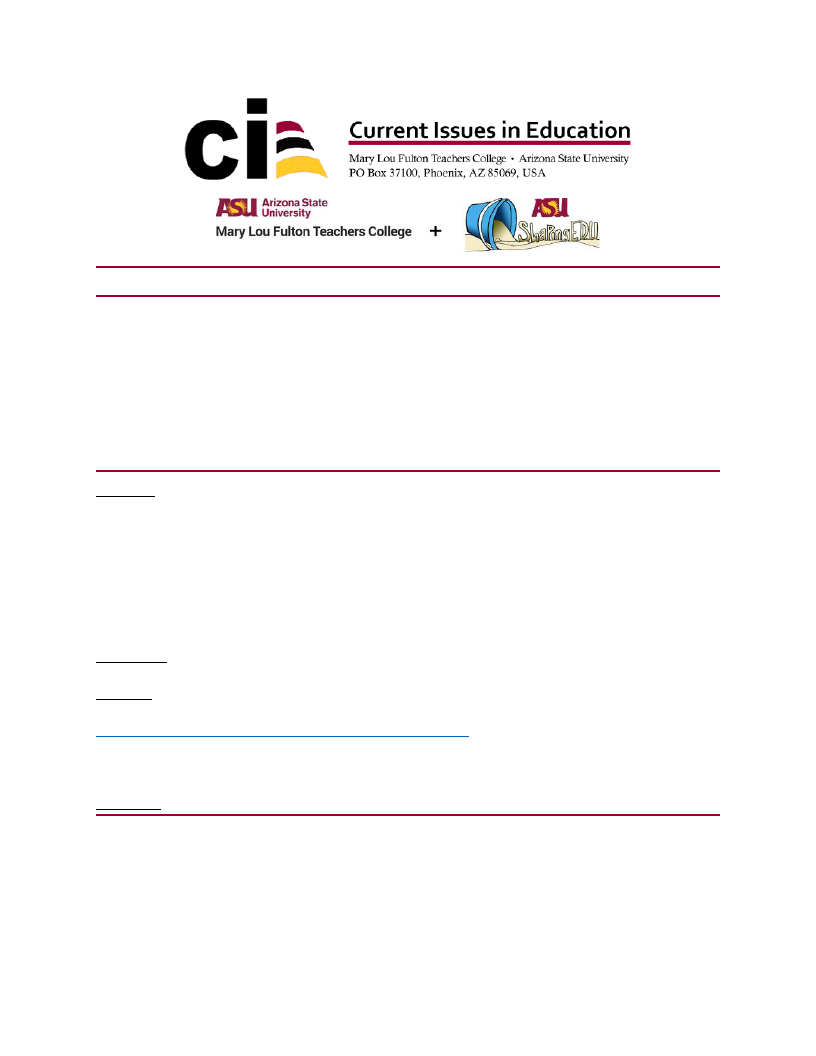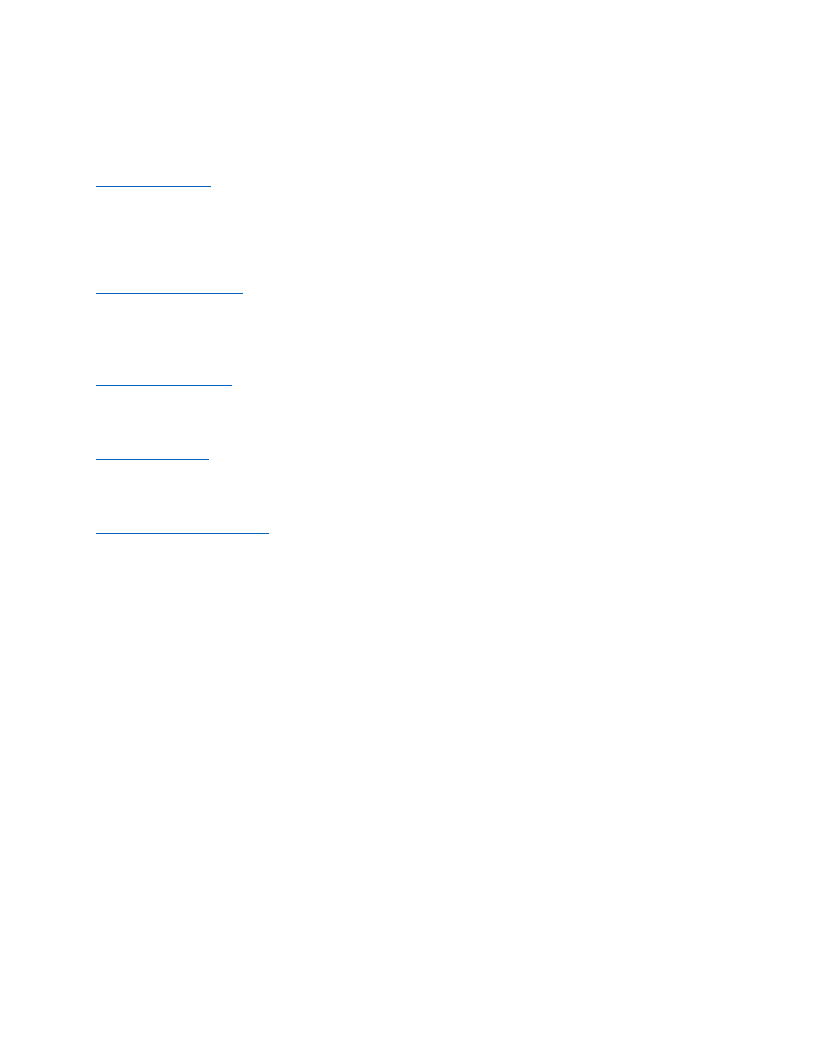
Volume 22, Issue 1
January 7, 2021
ISSN 1099-839X
Shaping the Futures of Learning in the Digital Age
Innovatively Preparing the Teacher Workforce:
Virtual Learning Environments
Anni Reinking
Southern Illinois University Edwardsville
Abstract: As one of the hardest professions, teaching can lead to burnout, stress, and other
physical and emotional reactions throughout one’s professional life. However, implementing the
innovative practice of training teachers in virtual learning environments can reduce stress and
increase the success of the teacher workforce. Therefore, in this study, the researchers focused on
a small group of novice teachers and teacher candidates in the Midwest in order to reduce initial
stress during teaching segments. The findings indicate that practice and coaching, within a
virtual learning environment, can reduce stress. However, feedback and peer interactions are also
essential.
Keywords: Stress, Teachers, Virtual learning environment
Citation: Innovatively preparing the Teacher workforce: Virtual learning environments. Current
Issues in Education, 22(1). Retrieved from
http://cie.asu.edu/ojs/index.php/cieatasu/article/view/1906 This submission is part of a special
issue, Shaping the Futures of Learning in the Digital Age, guest-edited by Sean Leahy, Samantha
Becker, Ben Scragg, and Kim Flintoff.
Accepted: 11/2/2020
Innovatively Preparing the Teacher Workforce:
Virtual Learning Environments
Across the nation school districts and classrooms are experiencing a teacher shortage,
which is creating an atmosphere where many schools are “scrambling to find qualified teachers”
(Papay et al., 2018, para. 1). The result is often placing unqualified or underqualified individuals
in classrooms with students. While this is a reality, it is not a goal or an effective best practice in
education.
Current Issues in Education, 22(1)
1

Reinking: Innovatively Preparing the Teacher Workforce
Researchers and policymakers have studied this shortage and report the complexity of the
reasoning behind the shortage. It spans from low pay to lack of preparedness (Walker, 2019).
Although these roadblocks, along with many others, are recognized, arguably policymakers have
“historically failed to … understand and fix the problems contributing to the shortage” (Walker,
2019, para. 14). However, groups of researchers around the nation have started to take the charge
of addressing a handful of issues leading to teacher shortage through the innovative and
immersive practice of virtual learning environments.
One of the areas researchers have focused on, in reference to the teacher shortage or
burnout rates, is to focus on the teacher stress levels experienced in the classroom setting. Why
stress? In one study, stress was found to be one of the causes of teacher resignation (Dinham,
1993). Furthermore, other researchers have found that stress can lead to “burnout”, which means
“to tire or suffer due to a demanding job” (Rankin, 2016, para. 2). Some researchers have even
stated that teaching constitutes the hardest job of all in our society (Glasser, 1992).
As one of the hardest professions, teaching can lead to burnout, stress, and other physical
and emotional reactions throughout one’s professional life. However, researchers and educators,
who understand the impact of high stress environments in the teaching field, created effective
training, professional development, and techniques for teachers and teacher candidates to use as
a way to reduce the negative reactions and side-effects of high stress working environments
through the use of training teachers in low-stress virtual learning environments. Virtual learning
environments are rapidly demonstrating utility for expanding experiential learning for teachers,
as well as teacher candidates.
Virtual learning environments incorporate the learned knowledge of best practices with
“real life” situations in a simulated environment. These experiences offer safe, flexible, and
appropriate training conditions to practice pedagogical skills. In these environments, teachers are
coached and given real-time feedback, rather than after-lesson feedback or no feedback at all
with the time constraints of administrators. Additionally, in the virtual learning environment
there are avatars that are able to provide real-time responses, interruptions, questions, and
answers. The research on virtual learning classrooms indicates that there is a nine second
suspension of disbelief, in which the teachers and teacher candidates participating in the
experience feel as though they are teaching in a real classroom rather than in a simulated
classroom (Dieker et al., 2008). This suspension of disbelief assists in the training of teachers in
high-stress environments in a low-stress simulation.
Therefore, the purpose of this study was to focus on a small group of novice teachers and
teacher candidates in the Midwest in order to reduce initial stress during teaching segments,
which included addressing the practice of giving a lesson while students (avatars) displayed
challenging behaviors. The experience in the virtual learning environment for the novice teachers
and teacher candidates included virtual classroom simulations, in the moment
coaching/feedback, and peer critiques. This type of learning environment has been shown to
increase teachers’ confidence and proficiency on topics such as classroom management or
instruction, (Dieker et al., 2008), which, in effect, creates coping strategies to reduce stress in
future teaching experiences. It should also be noted that the findings reported in this paper are
part of a larger study focused on several other areas, however in this paper the level of stress will
be the focus.
Current Issues in Education, 22(1)
2

Reinking: Innovatively Preparing the Teacher Workforce
Theoretical Perspective
This study was based on two similar perspectives that focus the trajectory of moving a
professional from novice to expert. One of the perspectives was designed by Patricia Sawyer
Benner (1982) in the field of nursing known as the Trajectory of Novice to Expert. The second
theory was designed by Dreyfus and Dreyfus (1985), who named the model after themselves, the
Dreyfus Model (2004). This specific model took the ideas of Benner’s model and focused
specifically on teachers moving from novice to expert through five levels:
1. Novice
2. Advanced Beginner
3. Competent
4. Proficient
5. Expert
The Dreyfus Model represents the widely agreed upon notion that professionals move
through a developmental continuum in which they progress from a novice to an expert.
Specifically, Dreyfus and Dreyfus (1985) identified that professionals move through five stages
of career development, which has an impact on future success and career sustainability.
Therefore, through the use of the Dreyfus Model (Dreyfus, 2004) the researchers were able
develop an understanding of where each teacher and teacher candidate began and the growth or
development experienced during the innovative and immersive practice of virtual learning.
Methodology
In this qualitative study, specifically grounded theory, researchers integrated the
innovative and immersive technology of virtual learning as a way to educate the teacher
workforce and develop a sense of confidence and sustainability within the profession. The
purpose of this study was to focus on a small group of novice teachers and teacher candidates at
in the Midwest in order to reduce initial stress during teaching segments. The researchers also
developed an overarching question for this specific portion of the larger study. The research
question was: How did the interactions in the virtual learning environment impact the
participants overall learning and sense of confidence?
Background
The research occurred in two teacher education courses at a four-year university in the
Midwest and at professional development sessions for novice teachers in surrounding districts.
One course was titled Collaborative Professional, Family, and Community Relationships. This
course had novice early childhood teacher candidates and novice teachers enrolled in graduate
credit hours. The objectives of the course focused on the participants understanding the
importance of family and community in the life of a student and school building. The specific
assignment in this course, which related to stress reduction and workforce development, focused
on the practice of co-teaching a lesson with a peer.
The second course included in this study was titled Learning Environments. This course
enrolled both elementary and early childhood novice teacher candidates. The objectives of the
course included learning about classroom management theories, interacting with various
teaching styles, and developing challenging learning environments for students. The specific
assignment in this course, which related specifically to reducing stress through clear classroom
Current Issues in Education, 22(1)
3

Reinking: Innovatively Preparing the Teacher Workforce
practices and procedures, focused on implementing classroom management techniques that had
been learned in the course.
Finally, the professional development included in this study varied for each group of
novice teachers, however the focus on stress reduction and workforce longevity was constant.
Some of the professional developmental focused specifically on behavior management strategies
while others focused on the impact of trauma in the classroom. Regardless of the professional
development title, one goal was consistent throughout: reduce stress in the teaching workforce
through innovative and immersive experiences.
Participants
The participants in the study were selected through convenience sampling, which a
qualitative non-probability is sampling technique used when subjects are selected because of
their convenient accessibility and proximity to the researcher. All of the participants were part of
the courses listed above or professional development sessions utilizing the virtual learning
environment. It was made clear by both of the researchers that the students/participants did not
have to partake in the research; it would not impact their grade or standing within the school
district. Therefore, not every student/participant completed the research survey.
Overall, there were 89 participants. Fifty-eight or 65% of the participants were novice
teachers in the various professional development sessions. There were 12 participants or 20% of
the participants were pre-service teacher candidates in the Learning Environments course and 19
participants or 33% of participants were pre-service teacher candidates in the Collaborative
Professional, Family, and Community Relationships course. The specific demographics (i.e. age,
race, sex) of each participant was not collected during this study.
Procedures
The research began when the researchers engaged novice teachers in professional
development focused on behavior management, and novice teacher candidates in two teacher
preparation courses. The participant engaged in coursework or training focused on a specific
topic, such as behavior management strategies, prior to entering the virtual learning environment.
After the coursework and/or professional development, the participants interacted with student
avatars in real time through the virtual simulation. While the virtual simulations varied, the level
of stress-inducing behaviors was set at a high level. Some examples of stress-inducing behaviors
included ‘students’ (virtual avatars) hitting each other, talking back to the teacher, not listening,
and overall interrupting the lesson. All of the interactions the avatar students displayed were
based in real classroom scenarios to provide a realistic experience for the participants to practice
and to build confidence and perseverance in the classroom setting. By engaging in this practice
in a real-time simulated environment, the participants were able to practice stress coping
strategies, as well as teaching strategies in a low risk environment (i.e. ‘no students were hurt in
the training of this teacher’.)
The process to the virtual simulations, during the simulation, and after the simulation
were all similar. First, as stated above, all of the participants received a version of training.
Second, the participants engaged in the virtual learning environment while the professor/trainer
and peers watched in a fishbowl setting. If a participant became overwhelmed during the
simulation, they were able to pause and regroup. After the simulation, the participant received
feedback from his/her peers and the professor/trainer. Through this process, the participant not
Current Issues in Education, 22(1)
4

Reinking: Innovatively Preparing the Teacher Workforce
only learns from the feedback, but each of the peers in the lab also learn from the feedback,
therefore creating more knowledge and confidence as a professional.
After the experience, as a way to analyze the impact of the virtual learning environment,
surveys were distributed to participants and qualitatively analyzed. As a reminder, this was a
larger study, however the information focused on reducing stress-levels will be reported.
Data Analysis
Once all of the participants implemented their lesson in the virtual learning environment,
the researchers provided a survey for the participants to complete. The survey included open
ended questions regarding the teacher candidates’ experience in the virtual learning environment.
One example of a question on the survey that relates directly to the stress- reduction study was,
“Did you confidence level change after participating the virtual learning environment? Explain.”
After the eighty-nine surveys were received, the researchers analyzed and coded the data
simultaneously. The grounded theory process was used for analyzing the data, which is a way to
find the development of conceptual categories. The themes focused on this specific portion of the
larger study (i.e. stress reduction) was evident in written feedback on the surveys focusing on the
ability to practice teaching techniques in a low-risk environment, along with receiving
constructive feedback from the professor/trainer and peers. These specific findings will be
discussed.
Findings
Implementing innovative and immersive experiences through the virtual learning
environment in teacher training programs, both for pre-service and in-service teachers, has the
potential to reduce stress and burnout in the teacher workforce. The teacher workforce is able to
practice, try, and receive feedback in a low-stress environment without the pressure of impacting
real students. The founding themes from this study, specifically aimed at reducing stress for the
teacher workforce, include two areas: consistency/calm and feedback.
Consistency/Calm
The ability to think under pressure, cope with changes in the structure of a day, and
calmly handle the flexibility of the teaching profession can be summarized in the theme of
consistency/calm. This concept was found after data analysis; however, a few quotes provide
context. One participant stated, “I forgot y’all were even in here. That was stressful, but I paused
and got it back together. That was nice.” Another participant stated, “I was relaxed and
composed, even when the students acted out.”
The ability to practice in a low-risk learning environment, rather than a high-risk “real”
environment, provided the participants the ability to relax rather than increase their levels of
stress. Another participant stated, “Things will never go exactly the way you planned them and
that is okay.” This statement points to the concept that staying calm under press is an imperative
quality to embrace as a teacher. Finally, one other participant stated, “I was stressed out prior to
the simulation, but I like having the practice to interact with students (in the simulation) and
seeing what I can work on before I’m in my future classroom.”
Although this was a qualitative study, the data indicated that 52% of the responses on the
survey reflected the overwhelming feeling of consistency/calm, as opposed to stress, in the
virtual learning experience. Overall, the innovative practice of virtual learning displayed a
reduction in stress for the participants, as well as a sense of confidence to take the skills they
learned and practiced into their real classrooms.
Current Issues in Education, 22(1)
5

Reinking: Innovatively Preparing the Teacher Workforce
Feedback
Feedback, the second theme, also provided a reduction in stress for the participants. The
participant comments and reactions focused on the feedback that was provided in the fishbowl
setting from peers and the professor/trainer during the virtual learning environment. The
reduction in stress, especially when difficult disruptions arose in the classroom, was evident in
one participant statement, “I was able to pause the classroom (in the virtual learning
environment) if I had a question. I could make mistakes without actually effecting real students.”
Another participant stated, “I like the fishbowl. I think it is a great way to bounce ideas off of
other students, and it is just a more engaging way to talk about things. I like hearing what others
have to say then being able to bound off of that” and implement the learned practices in the
virtual learning environment. These statements support the theme of feedback as a way to
brainstorm, collaborate, and overall reduce teacher stress.
Although this was a qualitative study, the data indicated that 97% of the participants
found the virtual learning experience transformative for practicing skills in a low-stress
environment where feedback can be asked for and received. Overall, the ability to provide
feedback, in real time, rather than after the moment, creates an environment where participants
work collaboratively to improve their practice, gain more confidence, and reduce stress.
Implications
There are implications from this study for both teacher training programs and the wider
teaching field. Implications specifically for the teacher training field include the ability to use
time more efficiently, increase the quality of feedback, and support the development of teacher
candidates’ confidence levels in classroom settings. Specifically, traditional teacher preparation
programs place pre-service teachers in classrooms immediately, with none to limited training.
This creates an environment of high-stress, low-confidence, and the possibility of learning or
solidifying inefficient teaching practices. Overall, this is an inefficient use of time in teacher
preparation programs. However, virtual learning environments have the potential to increase
coaching/feedback time, build teacher candidates’ confidence and knowledge of best practices
prior to entering a real classroom, and the ability for teacher candidates to ask in the moment
questions, rather than wait until the end of a school day.
This study also has implications for the wider teaching field. It has been stated that,
“most teachers deal with lots of job stress…. public school teachers face additional problems of
lack of respect from students, and even from students’ parents” (Brinson, 2018, para. 1 & 2).
One way to reduce the stress of dealing with increasingly demanding situations is through the
use of practicing, developing coping strategies, and discussing with professionals/peers on ways
to management changes in the teaching field. Virtual learning environments not only use
simulated students in real-time interactions, but there is also the ability to use adult avatars
simulated conversations with parents, principals, community members, school boards, and more.
Discussion
The process of implementing the virtual learning environment in both pre-service teacher
preparation programs and in-service teacher training workshops/professional development
sessions could revolutionize the teaching field. The virtual learning environments provide low-
risk, innovative, and immersive environments to practice, learn, and improve teaching strategies,
as well as problem-solve through difficult situations based on a real classroom. The experiential
learning, implemented through the virtual learning environment, allows teachers and teacher
Current Issues in Education, 22(1)
6

Reinking: Innovatively Preparing the Teacher Workforce
candidates to actively construct their knowledge acquisition by experiencing the learning context
(Kolb, 1984). This type of experiential learning, through the immersive virtual learning
environment, has the potential to serve as an intensive learning experiences for educators without
potential harmful effects on student performance, reducing both student and teacher stress-levels.
Overall, simulation in virtual learning environments has existed in other disciplines for
many years, however it is new to the field of education. Airplane pilots, police officers, and
healthcare professionals use virtual simulation. Many fields outside of education understand the
transformative potential of virtual simulation to increase confidence and reduce stress when
under pressure. Therefore, the implementation of virtual learning environments in the field of
education is important, needed, and reduces the stress level in one of the most stressful
professionals in our country. In order to increase student performance and decrease teacher
stress, implementing virtual learning environments can have the intense impact of restructuring
the profession of teaching.
References
Benner, P. (1982). From novice to expert. AJN The American Journal of Nursing, 82(3), 402-
407.
Brinson, L. C. (2019). 10 most stressful jobs in America. How Stuff Works. Retrieved from
https://money.howstuffworks.com/10-most-stressful-jobs-in-america7.htm
Dieker, L., Hynes, M., Hughes, C., & Smith, E. (2008). Implications of mixed reality and
simulation technologies on special education and teacher preparation. Focus on
Exceptional Children, 40(6), 1.
Dinham, S. (1993). Teachers under stress. The Australian Educational Researcher, 20(3), 1-16.
Retrieved from https://link.springer.com/article/10.1007/BF03219547
Dreyfus, S. E. (2004). The five-stage model of adult skill acquisition. Bulletin of Science,
Technology & Society, 24(3), 177-181.
Glasser, W. (1992). The quality school curriculum. The Phi Delta Kappan, 73(9), 690-694.
Kolb, D. A. (1984). Experiential learning. Prentice Hall.
Kyriacou, C. (2001). Teacher stress: Directions for future research. Educational Review, 53(1),
27-35.
Papay, J. P., Bacher-Hicks, A., Page, L.C., & Marinell, W. H. (2018, January 9). American’s
teacher shortage can’t be solved by hiring more unqualified teachers. The Washington
Post. Retrieved from
https://www.washingtonpost.com/news/posteverything/wp/2018/01/09/americas-teacher-
shortage-cant-be-solved-by-hiring-more-unqualified-teachers/?utm_term=.c3cde92363ed
Rankin, J. G. (2016, November 22). The teacher burnout epidemic, Part 1 of 2. Psychology
Today. Retrieved from https://www.psychologytoday.com/blog/much-more-common-
core/201611/the-teacher-burnout-epidemic-part-1-2
Walker, T. (2019, April 3). Teacher shortage is ‘real and growing, worse than we thought’.
neaToday. Retrieved from http://neatoday.org/2019/04/03/how-bad-is-the-teacher-
shortage/
Current Issues in Education, 22(1)
7

Reinking: Innovatively Preparing the Teacher Workforce
Author Notes
Anni Reinking
Southern Illinois University Edwardsville
anreink@siue.edu
Guest Editor Notes
Sean M. Leahy, PhD
Arizona State University, Director of Technology Initiatives
sean.m.leahy@asu.edu
Samantha Adams Becker
Arizona State University, Executive Director, Creative & Communications, University
Technology Office; Community Director, ShapingEDU
sam.becker@asu.edu
Ben Scragg, MA, MBA
Arizona State University, Director of Design Initiatives
bscragg@asu.edu
Kim Flintoff
Peter Carnley ACS, TIDES Coordinator
kflintoff@pcacs.wa.edu.au
Current Issues in Education, 22(1)
8

Reinking: Innovatively Preparing the Teacher Workforce
Volume 22, Issue 1
January 7, 2021
ISSN 1099-839X
Readers are free to copy, display, and distribute this article, as long as the work is attributed to the
author(s) and Current Issues in Education (CIE), it is distributed for non-commercial purposes only, and no alteration
or transformation is made in the work. More details of this Creative Commons license are available at
http://creativecommons.org/licenses/by-nc-sa/3.0/. All other uses must be approved by the author(s) or CIE. Requests
to reprint CIE articles in other journals should be addressed to the author. Reprints should credit CIE as the original
publisher and include the URL of the CIE publication. CIE is published by the Mary Lou Fulton Teachers College at
Arizona State University.
Editorial Team
Consulting Editor
Neelakshi Tewari
Lead Editor
Marina Basu
Section Editors
L&I – Renee Bhatti-Klug
LLT – Anani Vasquez
EPE – Ivonne Lujano Vilchis
Review Board
Blair Stamper
Melissa Warr
Monica Kessel
Helene Shapiro
Sarah Salinas
Faculty Advisors
Josephine Marsh
Leigh Wolf
Current Issues in Education, 22(1)
9
